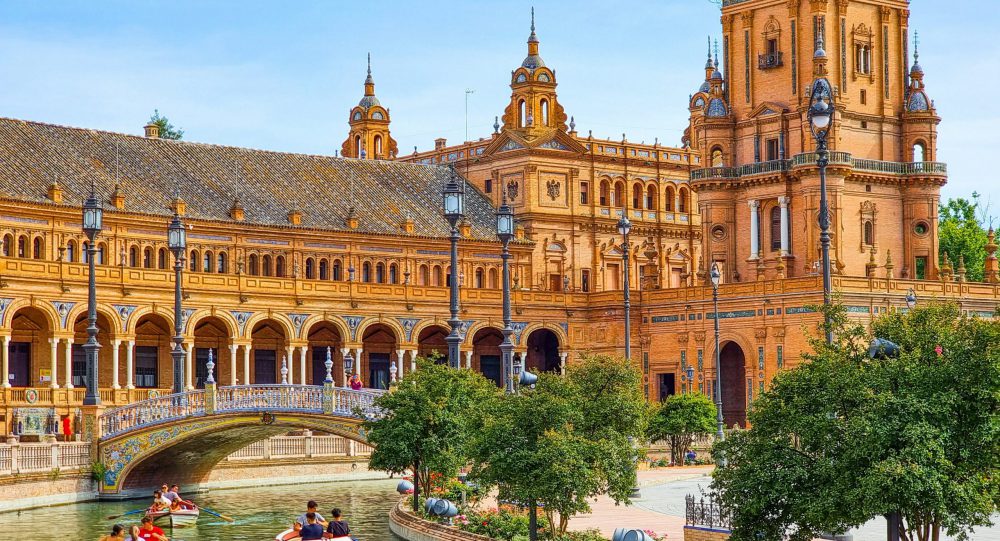I am writing this blog post a couple days after the events herein described. My precision of detail may be effected due to a lack of photos in my phone gallery. I digress and will do my best to summarize the key events of the day.
On March 5, 2024, the UMass Lowell students visiting Seville, Spain received a lecture on Seville’s architectural history and various influences over many centuries, followed by a guided tour of the Plaza del Toros, a famous bullfighting ring. After 4:30 PM, all students had free time to explore the city as they wished.
Starting my day
I set many alarms with the intention of observing and attending either some morning organ music or a mass at the Cathedral of Seville. This largely depended on the alarm with which I would arise. I ended up attending a Catholic mass in Spanish and enjoyed trying to make out the readings and the order of mass being recited. I had never attended a mass in another country or language before and appreciated the experience. I observed that three priests concelebrated the mass (did the ritual together), a small men’s choir sang the psalms and other material during the ceremony, and staff ushered all attendees out before 11:00, when the cathedral was opened to tourists. I’m glad I made this solo trip in the morning because it gave me a reason to be up early and I felt greatly immersed in Seville’s Catholic culture. It was a gorgeous day, as you can see from the below photo of the Cathedral of Seville.

Puerta de Jerez and University of Seville
Leaving the cathedral, I picked up freshly squeezed orange juice from a shop across from the Royal Alcazar in the Plaza del Triunfo. Meeting up with the rest of the group at Puerta de Jerez, we took a short walk down the street to the University of Seville campus. Upon meeting our guest lecturer, a professor of Islamic and Arabic studies at the university, we received a brief but comprehensive background on the University of Seville and the building in which we studied. This main building, now housing history and other social science programs, used to be a tobacco factory where women would prepare cigarettes and other tobacco products by hand until machines made the demand for tobacco easier to manage.
Professor Jose Maria also has a background in architecture along with his primary study of comparative religions and Islamic history. He covered the various walls of Seville over many centuries of both Roman and Muslim rule, relating them to other notable wall structures of ancient and medieval Europe. Discussing the term mudejar in the context of architecture, the professor emphasized the Arabic and Islamic features present in both the Royal Alcazar and Plaza de Espana. Although the below image is not from this same day, it shows the “Neo Mudejar” style consistent throughout the whole of Plaza de Espana. Built for the 1929 World Expo, this iconic landmark features ample horseshoe arches which are on occasion in groupings of three and five, which are also seen in the Royal Alcazar. I also noticed when visiting that the back entrances are similar to the distinctly Moorish design feature of the Royal Alcazar in which the entrance doesn’t open up to an immediate view of the other side, but has the option to either turn left or right around a large wall obstructing the view.

Many more locations and architectural marvels throughout the city were discussed, but for the sake of brevity I will move on. Professor Jose Maria concluded his presentation by thoroughly explaining how to read the Arabic inscriptions in the entranceway to the Royal Alcazar. This phrase praises Allah as the one, true God. It is repeated and reflected four times when the below blue and white mosaic is viewed from left to right. Another major takeaway of the presentation was that Moorish architecture is characteristic of being geometric, patterned, and depicting animals. The tree of life is also represented in Muslim, Christian, and Jewish buildings throughout Spain and Europe.

Time with Kepa from API
Following a brief break for an opportunity to get lunch, students rendezvoused at the Puerta de Jerez to join our guides Kepa and Juan Calvo. Kepa explained the history behind some slightly hidden gems of the nearby streets. Most notable among these were the Torre de Oro and the Torre de la Plata. Tucked behind modern buildings, Torre de la Plata is a 13th Century storage space for silver. The wall connected to it also dates back to the Almohad caliphate. Torre de Oro, a much larger tower along the Guadalquivir River, was also discussed along the tour. Students also took photos by the 500th anniversary replica of the Victoria, the last ship to return from Ferdinand Magellan’s journey to circumnavigate the globe. I was shocked and expected the ship to be much larger. It was comparable or smaller to the size of amusement park pirate ship rides. Below is an image of the replica museum.

Until Next Time…
Great fun and memories with new friends, a tour of a bullfighting ring, and exploring Calle Sierpes (a well known shopping street) were among the highlights of my day following the tour with Kepa. I have treasured all my time here in Seville so far, the new friends I’ve been making, and the passionate staff at API who have made this trip so memorable.
Thank you to all who organized this excursion.
In lieu of further exposition, here are some images representing the remainder of my day.



